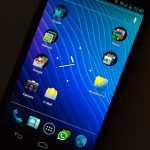 Ich muss zugeben: bisher hat mich Android immer ein klein wenig abgeschreckt. Zu geringe App-Auswahl, kein einheitliches Bedieninterface und eine grausame Update-Politik. Dann ist mir ein verhältnismäßig günstiges Samsung Galaxy Nexus in die Finger gefallen, sodass ich Android (jetzt 4.0.2) eine Chance geben will. Zu meinem Smartphone-Hintergrund: bisher war ich iOS-User. Eingestiegen mit einem iPhone 3G, dann das 3GS übersprungen und aktuell mit einem iPhone 4 unterwegs. Davor jahrelang Nokia-Smartphones, angefangen beim Nokia 6600 bis hin zum E90 Communicator. Nun also das Galaxy Nexus.
Ich muss zugeben: bisher hat mich Android immer ein klein wenig abgeschreckt. Zu geringe App-Auswahl, kein einheitliches Bedieninterface und eine grausame Update-Politik. Dann ist mir ein verhältnismäßig günstiges Samsung Galaxy Nexus in die Finger gefallen, sodass ich Android (jetzt 4.0.2) eine Chance geben will. Zu meinem Smartphone-Hintergrund: bisher war ich iOS-User. Eingestiegen mit einem iPhone 3G, dann das 3GS übersprungen und aktuell mit einem iPhone 4 unterwegs. Davor jahrelang Nokia-Smartphones, angefangen beim Nokia 6600 bis hin zum E90 Communicator. Nun also das Galaxy Nexus.
Der erste Eindruck nach dem öffnen der Packung: was für ein riesiges Display. Mit 4,65 Zoll deutlich größer als das des iPhone 4 (3,5″), dabei leicht konkav. Nach dem Einschalten: satte Farben, eine flüssige Einschaltanimation. Dann mein erster Kontakt mit Android 4.x „Ice Cream Sandwich“: die Benutzeroberfläche wird flüssig dargestellt, auch der Launcher öffnet sich sofort ohne Verzögerung. Die Funktionen des ständig eingeblendeten Menüs sind leicht verständlich: ganz links geht es einen Schritt zurück, in der Mitte auf den Home-Screen (oder, wenn der Button dort gedrückt wird, in den Launcher) und ganz rechts werden die aktuell laufenden Anwendungen aufgelistet (die mit einem Wisch nach links oder rechts beendet werden können). Anders als iOS kann Android echtes Multitasking, sodass ich schnell die Erfahrung gemacht habe, dass man schon etwas darauf achten sollte, was im Hintergrund am Akku saugt.
Nachdem die grundlegende Einrichtung erledigt war (auch auf dem iPhone verwalte ich meine Mails, Termine und Kontakt via Googlemail, sodass sich diese Daten leicht übernehmen ließen) mussten noch einige Apps geladen werden. Dabei fiel auf: noch nicht alles ist für die Display-Auflösung von 1.280 x 720 Pixel gedacht. So wird die Schrift in der Spiegel-Online-App leider zu klein dargestellt, Bilder liegen ebenfalls nicht im richtigen Format vor. Hier macht es die Webseite besser. Andere Apps sind dagegen kein Problem, ein eigentlich simples „Uhr“-Widget führte aber dazu, dass die CPU durchgehend ausgelastet wurde – Gift für die Akkuleistung, über die ich mir noch kein Urteil erlaube.
Apropos Webseiten: Standard-Browser ist natürlich eine Webkit-Variation, auf die eigentlich alle Smartphone-Anbieter abseits von Microsoft setzen. Parallel habe ich noch die Beta 10.0 von Firefox Mobile (Fennec) installiert, womit es etwas leichter ist, Webseiten, die keine mobile Version haben, korrekt darzustellen. Außerdem gibt es hier die meisten vom Firefox bekannten Plugins. Bei zumeist weißen Webseiten fiel allerdings auf, dass es bessere Display-Technologien gibt: ein leichter grauschleier stellt sich ein, wenn man die Helligkeit der Automatik überlässt. Regelt man sie selbst hoch, verringer sich dieser Effekt. Das LCD des iPhone 4 („Retina Display“) bleibt trotz ähnlicher Pixeldichte dem Pentile-AMOLED des Samsung Galaxy Nexus überlegen – auch wenn letzteres mit sehr guter Schärfe überzeugt, bleibt doch der leicht „schmutzige“ Eindruck.
Bisheriges Fazit: mit Android 4.0.x (mein Nexus sollte demnächst da Update auf 4.0.3 over-the-air (OTA) bekommen) ist Google definitv au dem richtigen Weg. Auch die Richtlinie, dass alle Hersteller neben ihren eigenen Lösungen auch die pure Android UI mitliefern müssen, wird die App-Entwicklung hoffentlich vereinfachen. Die Zeit wird zeigen, ob das System (und das Galaxy Nexus als Hardware-Basis) dem iPhone gefährlich werden können. Nach gut einem Tag vermisse ich iOS nicht – als nächstes werde ich das Nexus als Navigation im Auto ausprobieren; Hier tritt dann Sygic mit TomTom-Karten gehen Navigon auf dem iPhone 4 an. Und natürlich wird es hier Updates geben, wie es mir mit Android weiter ergeht…
